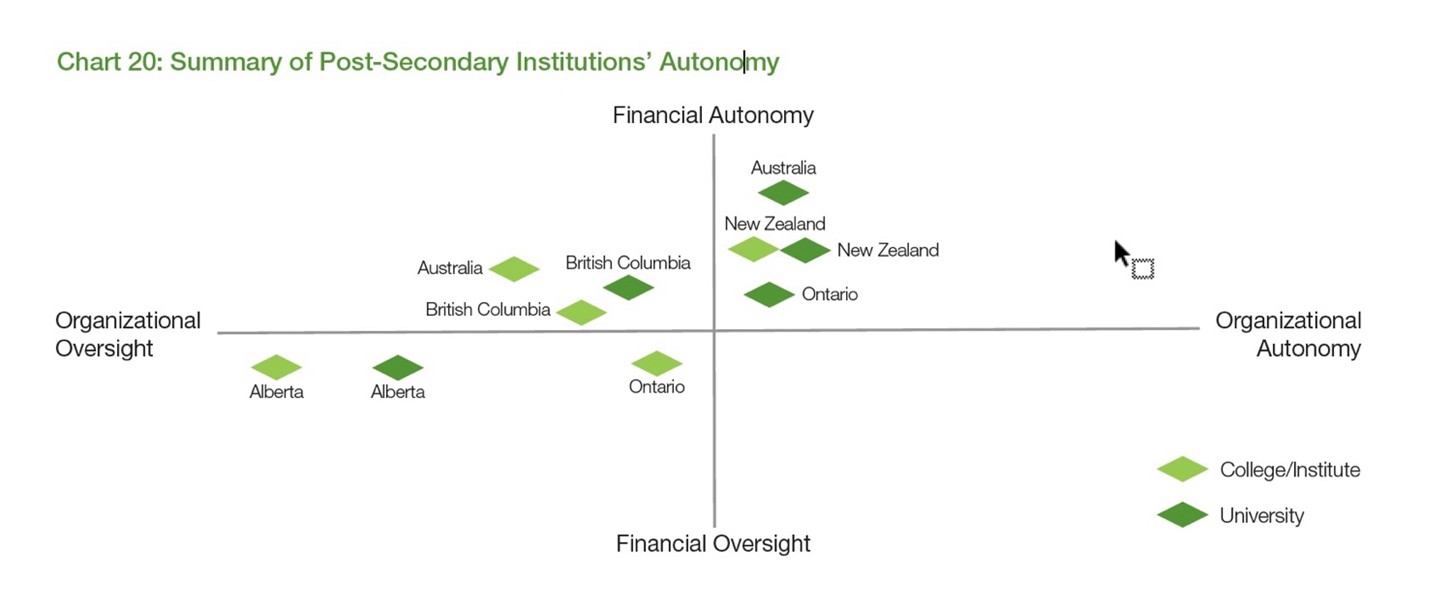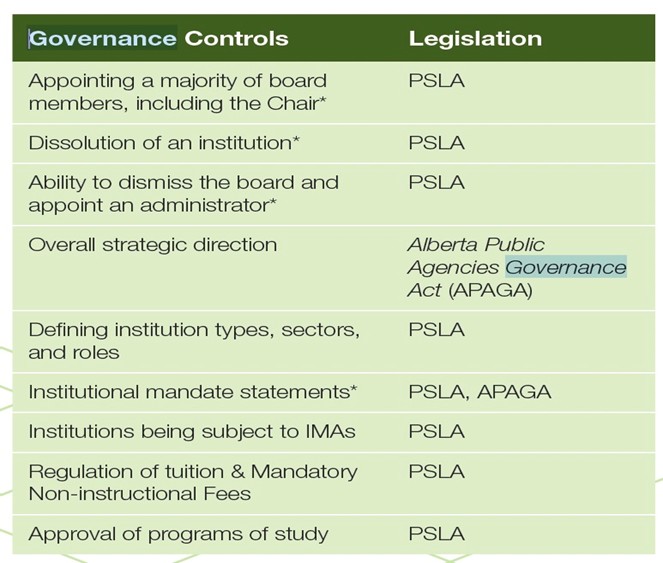The Potential Governance Implications of Alberta’s Expert Panel on Post-Secondary Institution Funding and Alberta’s Competitiveness
by Cheryl Foy
Context
Several Canadian provinces (Nova Scotia, Ontario and B.C.) are actively engaged in or planning a review of university governance models. Alberta is a province in which the government has exerted more organizational and financial control over its post-secondary institutions. It is one of two provinces (BC is the other) that has a single piece of legislation, the Post-Secondary Learning Act, that creates and regulates all Alberta post-secondary institutions including universities. Other provinces often look to Alberta when they are considering increasing accountability or control measures. A recent Expert Panel report (described in more detail below) recommends that Alberta reduce its levers of control and take measures to increase the autonomy of some institutions. It will be interesting to see the government’s reaction, and to what extent, if any, the recommendations influence the policy direction of other provinces.
So … more about the Expert Panel Report …
The 2025 Mintz Panel Report and University Governance
A little less than a year ago, Alberta announced the formation of an “Expert Panel on Post-Secondary Institution Funding and Alberta’s Competitiveness”. Dr. Jack Mintz was appointed chair and, although comprised of five panel members, it became known as the “Mintz Panel”. The Mintz Panel recently issued its report and there are some interesting governance-relevant observations and recommendations.
What Was the Panel Asked To Do?
The panel’s mandate was threefold: a funding review, a review of other funding models (within Canada and globally), and an assessment of Alberta’s ability to “compete on a global level in higher education”. They weren’t specifically asked to look at governance but did so in the context of commenting on administrative and regulatory burdens on post-secondary institutions.
What Governance-Relevant Recommendations and Findings Did the Panel Make?
The Panel recommended that Alberta institutions be given more autonomy to raise revenue and reduce costs (Recommendation No. 8). The Panel recommended that the government reduce red tape and administrative reporting requirements for post-secondary institutions (Recommendation No. 9) and that the process for approving new programs should be streamlined (Recommendation No. 10).
Alberta has long been seen to be a jurisdiction within which its universities have lower governance autonomy as compared with other Canadian institutions, and the Panel confirmed this. Reproduced below is Chart 20 prepared by the Panel demonstrating that Alberta universities are subject to great organizational and financial oversight than other institutions in comparable jurisdictions.

The Panel advised the government to adopt a “continuum” approach and that some control over some institutions should be decreased, specifically suggesting that “it may be appropriate to provide more autonomy over the selection of the majority of public board members, appointment of the chair of the board, access to reserve funds or other regulatory controls to some categories of institutions but not to all. If significantly more autonomy is given to certain categories of institutions, those institutions would then be responsible for establishing governance practices to manage their own risks” (see page 78).
While noting that governance was not within their mandate, the Panel did note that they heard about governance concerns in the course of their work. Reproduced below is part of Chart 19 used by the Panel to illustrate the legislative source of governmental controls over Alberta institutions (see page 52).
Chart 19

With respect to Boards, the Panel notes that it heard concerns about the size of boards and their composition and encouraged the government to reduce the size and address “the balance between public membership and membership by institutional groups”. Note that this concern has been raised in other provinces[1]. The Panel doesn’t indicate what is wrong with the “balance” although presumably the desire would be to ensure a majority of “public” (external or independent) members and although this is possible under the PSLA, it is not assured. See section 16 of the Post-Secondary Learning Act Alberta which provides for a board composed of the Chair (appointed by LGIC), Chancellor, President, 9 constituent members (Alumni (2), Senate (1), Academic staff (2), undergraduate students (2), graduate students (1), and staff (1)) and not more than 9 members of the public. The government may also appoint additional members. The Alberta government appoints the board chair and most board members (with those coming from constituent groups being nominated by the constituency first).
The recommendation to reduce board size and ensure that a majority of board members are external and independent members along with decreasing government involvement in appointment of board members could be helpful in increasing university autonomy.
What to Watch For …
It is early days yet, but it will be interesting to see what, if any, action the Alberta government takes in response to the Expert Panel recommendations and how this response influences university governance policy activity in other areas of the country.
[1] I have heard that this has been raised in Nova Scotia, and board size has been raised by the Auditor General of Ontario in the university value for money audits conducted there.
